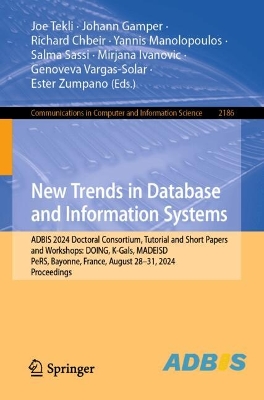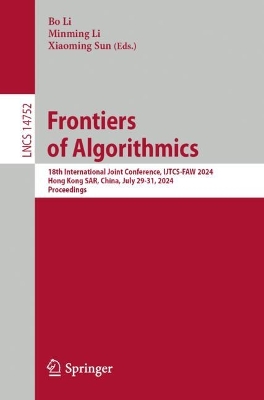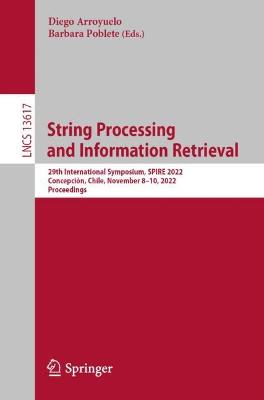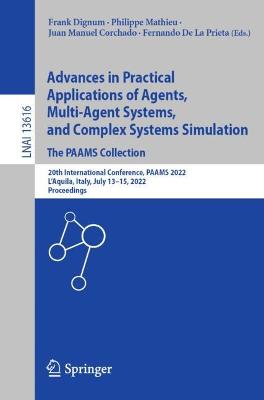Computational Collective Intelligence
 portes grátis
portes grátis
Computational Collective Intelligence
16th International Conference, ICCCI 2024, Leipzig, Germany, September 9-11, 2024, Proceedings, Part II
Franczyk, Bogdan; Ludwig, Andre; Kozierkiewicz, Adrianna; Nunez, Manuel; Treur, Jan; Vossen, Gottfried; Nguyen, Ngoc Thanh
Springer International Publishing AG
09/2024
395
Mole
9783031708183
15 a 20 dias
.- A deep learning approach to fine-grained political ideology classification on social media texts.
.- Enhancing Social Network Trust with Improved EigenTrust Algorithm.
.- An Empirical Analysis of the Usage of Requirements Attributes in Requirements Engineering Research and Practice.
.- Experimental Study on Link Prediction in Unweighted and Weighted Time-Evolving Organizational Social Network.
.- Assessing Student Quality of Life: Analysis of Key Influential Factors.
.- An Adaptive Network Model for Interpersonal Emotion Regulation in Multimodal Human-Bot Interaction.
.- Cybersecurity, Blockchain Technology, and Internet of Things.
.- Strengthening Network Intrusion Detection in IoT Environments with Self-Supervised Learning and Few Shot Learning.
.- Daily activities forecasting for long-term elderly behavior change detection.
.- Detection of Fake Facial Images and Changes in Real Facial Images.
.- TabGAN-powered Data Augmentation and Explainable Boosting-based Ensemble Learning for Intrusion Detection in Industrial Control Systems.
.- Malware detection among contact tracing apps with deep learning.
.- Cooperative Strategies for Decision Making and Optimization.
.- Modeling the Functioning of Decision Trees Based on Decision Rule Systems by Greedy Algorithm.
.- Delays in computing with parallel metaheuristics on HPC infrastructure.
.- Reinforcement Learning-Based Cooperative Traffic Control System.
.- Discovering Spatial Prevalent Co-location Patterns by Once Scanning Datasets without Generating Candidates.
.- New results for some Tur?an problem instances obtained using the reinforcement learning technique.
.- Computational Intelligence for Digital Content Understanding.
.- Impact of acquisition parameters on the performance of radiomic systems.
.- Feature Explainability and Enhancement for Skin Lesion Image Analysis.
.- Toward Intelligent Ethnicity Recognition and Face Anonymization: An IncepX-Ensemble Model Approach.
.- Weak Supervised Asphalt Pavement Segmentation.
.- New Presence-Dependent Binary Similarity Measures for Pairwise Label Comparisons in Multi-label Classification.
.- Synergistic Feature Fusion for Improved Classification: Combining Dempster-Shafer Theory and Multiple CNN Architectures.
.- Knowledge Engineering and Application for Industry 4.0.
.- High learning hierarchical neural networks.
.- A new method of detecting Alzheimer's disease.
.- GCC Aware Glaucoma Detection Using Macula OCT Image Analysis Based on Deep Convolutional Neural Networks.
.- Understanding Geometric Relationship Concepts in Few-Shot Learning.
.- Applicability criterion of the Non Overlapping Template Matching algorithm from NIST Statistical Test Suite SP800-22 for long aperiodic patterns.
.- Enhanced Activity Recognition through Joint utilization of Decimal Descriptors and Temporal Binary Motions.
.- Using Multilevel Temporal Factorisation to Analyse Structure and Dynamics for Higher-Order Adaptive and Evolutionary Processes.
.- A deep learning approach to fine-grained political ideology classification on social media texts.
.- Enhancing Social Network Trust with Improved EigenTrust Algorithm.
.- An Empirical Analysis of the Usage of Requirements Attributes in Requirements Engineering Research and Practice.
.- Experimental Study on Link Prediction in Unweighted and Weighted Time-Evolving Organizational Social Network.
.- Assessing Student Quality of Life: Analysis of Key Influential Factors.
.- An Adaptive Network Model for Interpersonal Emotion Regulation in Multimodal Human-Bot Interaction.
.- Cybersecurity, Blockchain Technology, and Internet of Things.
.- Strengthening Network Intrusion Detection in IoT Environments with Self-Supervised Learning and Few Shot Learning.
.- Daily activities forecasting for long-term elderly behavior change detection.
.- Detection of Fake Facial Images and Changes in Real Facial Images.
.- TabGAN-powered Data Augmentation and Explainable Boosting-based Ensemble Learning for Intrusion Detection in Industrial Control Systems.
.- Malware detection among contact tracing apps with deep learning.
.- Cooperative Strategies for Decision Making and Optimization.
.- Modeling the Functioning of Decision Trees Based on Decision Rule Systems by Greedy Algorithm.
.- Delays in computing with parallel metaheuristics on HPC infrastructure.
.- Reinforcement Learning-Based Cooperative Traffic Control System.
.- Discovering Spatial Prevalent Co-location Patterns by Once Scanning Datasets without Generating Candidates.
.- New results for some Tur?an problem instances obtained using the reinforcement learning technique.
.- Computational Intelligence for Digital Content Understanding.
.- Impact of acquisition parameters on the performance of radiomic systems.
.- Feature Explainability and Enhancement for Skin Lesion Image Analysis.
.- Toward Intelligent Ethnicity Recognition and Face Anonymization: An IncepX-Ensemble Model Approach.
.- Weak Supervised Asphalt Pavement Segmentation.
.- New Presence-Dependent Binary Similarity Measures for Pairwise Label Comparisons in Multi-label Classification.
.- Synergistic Feature Fusion for Improved Classification: Combining Dempster-Shafer Theory and Multiple CNN Architectures.
.- Knowledge Engineering and Application for Industry 4.0.
.- High learning hierarchical neural networks.
.- A new method of detecting Alzheimer's disease.
.- GCC Aware Glaucoma Detection Using Macula OCT Image Analysis Based on Deep Convolutional Neural Networks.
.- Understanding Geometric Relationship Concepts in Few-Shot Learning.
.- Applicability criterion of the Non Overlapping Template Matching algorithm from NIST Statistical Test Suite SP800-22 for long aperiodic patterns.
.- Enhanced Activity Recognition through Joint utilization of Decimal Descriptors and Temporal Binary Motions.
.- Using Multilevel Temporal Factorisation to Analyse Structure and Dynamics for Higher-Order Adaptive and Evolutionary Processes.







